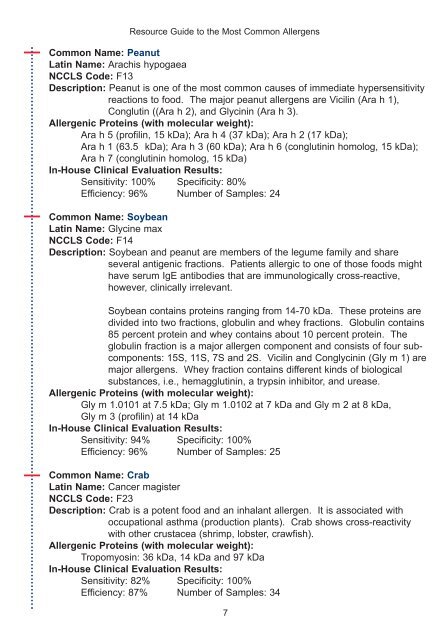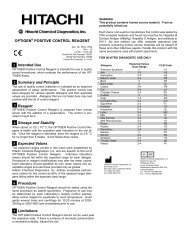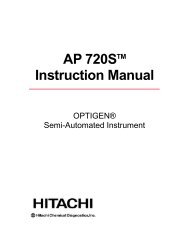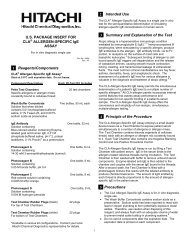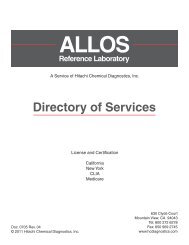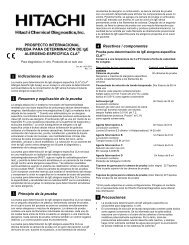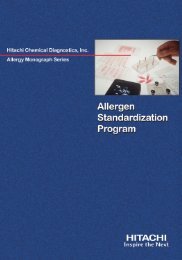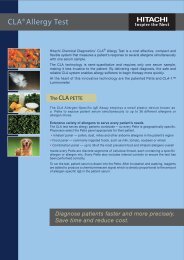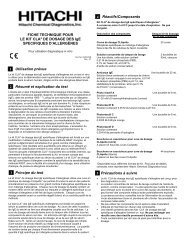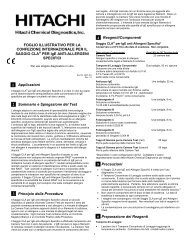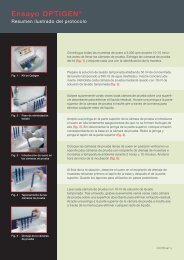Allergen Resource Guide - Hitachi Chemical Diagnostics
Allergen Resource Guide - Hitachi Chemical Diagnostics
Allergen Resource Guide - Hitachi Chemical Diagnostics
Create successful ePaper yourself
Turn your PDF publications into a flip-book with our unique Google optimized e-Paper software.
<strong>Resource</strong> <strong>Guide</strong> to the Most Common <strong>Allergen</strong>s<br />
Common Name: Peanut<br />
Latin Name: Arachis hypogaea<br />
NCCLS Code: F13<br />
Description: Peanut is one of the most common causes of immediate hypersensitivity<br />
reactions to food. The major peanut allergens are Vicilin (Ara h 1),<br />
Conglutin ((Ara h 2), and Glycinin (Ara h 3).<br />
<strong>Allergen</strong>ic Proteins (with molecular weight):<br />
Ara h 5 (profilin, 15 kDa); Ara h 4 (37 kDa); Ara h 2 (17 kDa);<br />
Ara h 1 (63.5 kDa); Ara h 3 (60 kDa); Ara h 6 (conglutinin homolog, 15 kDa);<br />
Ara h 7 (conglutinin homolog, 15 kDa)<br />
In-House Clinical Evaluation Results:<br />
Sensitivity: 100% Specificity: 80%<br />
Efficiency: 96% Number of Samples: 24<br />
Common Name: Soybean<br />
Latin Name: Glycine max<br />
NCCLS Code: F14<br />
Description: Soybean and peanut are members of the legume family and share<br />
several antigenic fractions. Patients allergic to one of those foods might<br />
have serum IgE antibodies that are immunologically cross-reactive,<br />
however, clinically irrelevant.<br />
Soybean contains proteins ranging from 14-70 kDa. These proteins are<br />
divided into two fractions, globulin and whey fractions. Globulin contains<br />
85 percent protein and whey contains about 10 percent protein. The<br />
globulin fraction is a major allergen component and consists of four subcomponents:<br />
15S, 11S, 7S and 2S. Vicilin and Conglycinin (Gly m 1) are<br />
major allergens. Whey fraction contains different kinds of biological<br />
substances, i.e., hemagglutinin, a trypsin inhibitor, and urease.<br />
<strong>Allergen</strong>ic Proteins (with molecular weight):<br />
Gly m 1.0101 at 7.5 kDa; Gly m 1.0102 at 7 kDa and Gly m 2 at 8 kDa,<br />
Gly m 3 (profilin) at 14 kDa<br />
In-House Clinical Evaluation Results:<br />
Sensitivity: 94% Specificity: 100%<br />
Efficiency: 96% Number of Samples: 25<br />
Common Name: Crab<br />
Latin Name: Cancer magister<br />
NCCLS Code: F23<br />
Description: Crab is a potent food and an inhalant allergen. It is associated with<br />
occupational asthma (production plants). Crab shows cross-reactivity<br />
with other crustacea (shrimp, lobster, crawfish).<br />
<strong>Allergen</strong>ic Proteins (with molecular weight):<br />
Tropomyosin: 36 kDa, 14 kDa and 97 kDa<br />
In-House Clinical Evaluation Results:<br />
Sensitivity: 82% Specificity: 100%<br />
Efficiency: 87% Number of Samples: 34<br />
7


